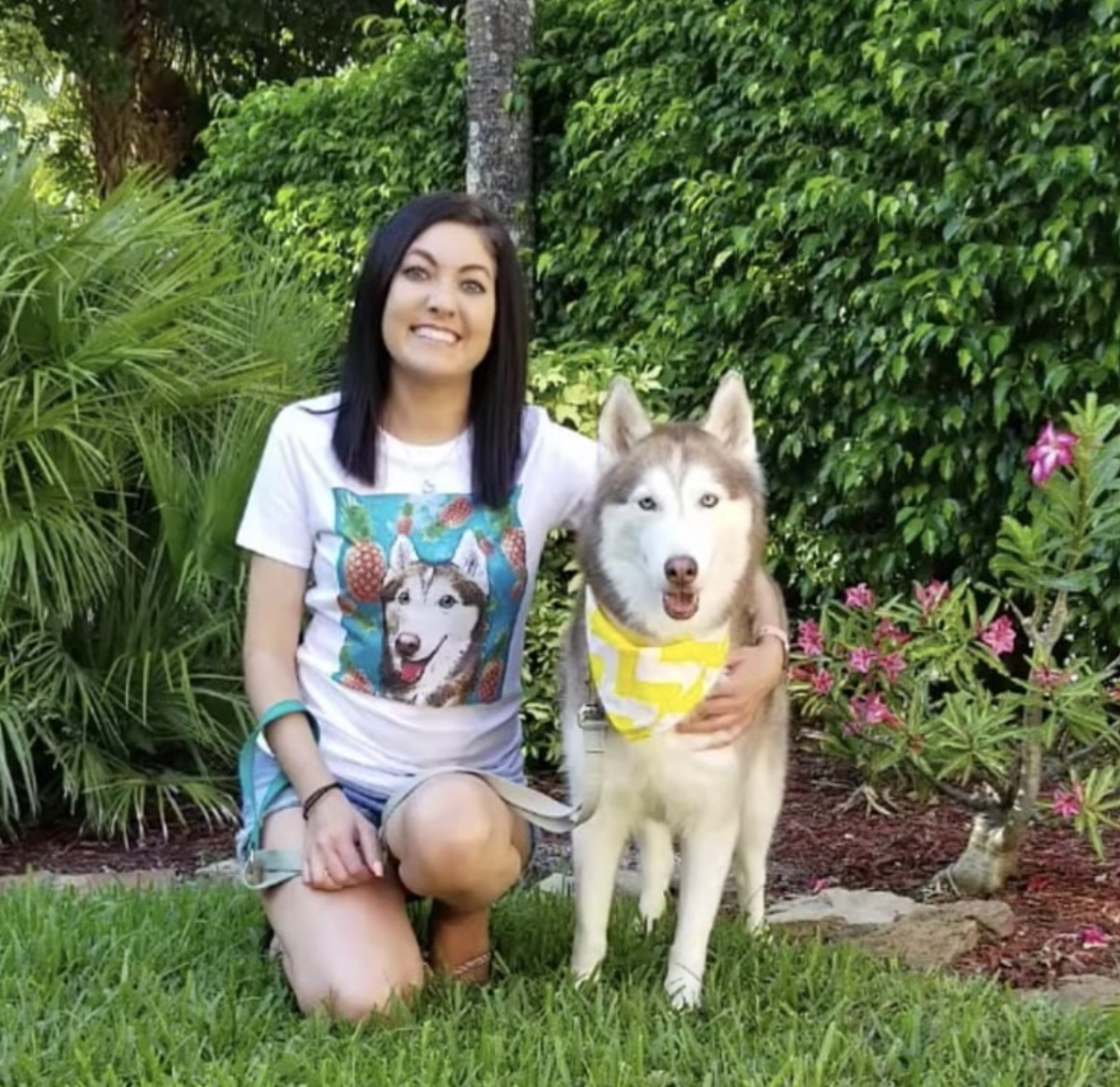Congrats—you made it through your fuzzy butterball’s first month home! Through your weary, sleep-deprived eyes, we give you this second chapter in our Puppy Survival Guide series for puppies aged 3–4 months. We’ll break down the most important milestones and steps to take for your puppy’s health and wellness, training, socialization, nutrition, safety, and physical development during their first year.
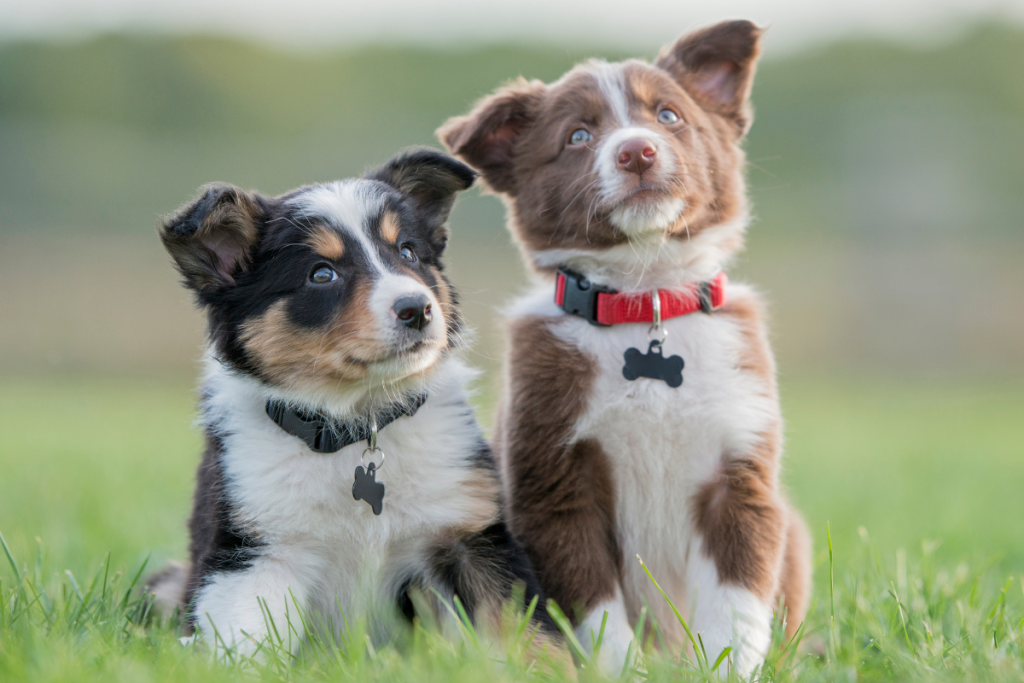

Cheat Sheet Checklist For 3–4 Month Old Puppies
Did TikTok kill your attention span so much that it’s tough to read through an entire article? We feel you! This essential task checklist covers the most important bite-sized info you need to crush months 3–4 of puppy-raising!
| Essential Task Checklist For Puppies Aged 3–4 Months |
|---|
| Month 3: ☐ Second vet visit at 12 weeks for second dose of core vaccines ——DA2PP or DAP ——Rabies if required by law at this age (check state requirements). ——Discuss suggested non-core vaccines with vet (Bordetella, flu, Lyme, leptospirosis). ☐ Third vet visit at 16 weeks for final puppy vaccines. ——DA2PP or DAP ——Rabies if not already given. ——Dental check ☐ Enroll in puppy classes (discuss with vet if puppy is not yet fully vaccinated). ☐ Monthly flea/tick/heartworm meds ☐ Continue introducing puppy to at least 90 different enjoyable experiences (sights, sounds, smells, people) by the time they hit 14 weeks. ☐Be aware that puppies go through fear periods during this time, where they may be more easily spooked by new things. Take introductions slowly and use lots of treats for rewards after new experiences. ☐ Work on basic commands, crate training, and continuation of potty training/no-bite training. ☐ Check to make sure all puppy teeth have come in. ☐ Start or continue dental care routine with daily toothbrushing (reward with yummy dental chews!). ☐ New purchases to consider: doggie nanny cam, microchip, monthly dental chew + toothpaste kit. Month 4: ☐ Monthly flea/tick/heartworm meds ☐ Once fully vaccinated and given the “ok” from your vet, feel free to explore more places and carefully introduce your puppy to other dogs in controlled situations. ☐ Decrease meals from 3x daily to 2x daily for small breed dogs at month 4 (medium/large breeds still need meals 3x/day). ☐ If permanent adult teeth are coming in, check to make sure the puppy teeth they’re replacing have fallen out. ☐ Consider pet insurance to avoid future exemptions due to pre-existing conditions. ☐ Consider early microchipping. |
What Tasks Should Be Completed Before Your Puppy Reaches 3 Months Old?
If you missed the first chapter of our Puppy Survival series, we suggest popping over there for a read before continuing with this second chapter. Here’s a quick recap of essential puppy tasks discussed in the previous Puppy Survival Guide 8-12 Weeks that should be started or completed during your puppy’s first month home when they are 8-12 weeks old:
- First vet appointment: DA2PP and DAP vaccine, deworming, start heartworm and flea/tick treatments.
- Set feeding/sleep routines and decide on puppy diet.
- Begin training: potty training, no biting, name recall, sit, walking on leash.
- Puppy proof home and vehicle.
- Purchase necessary puppy products: puppy food, ID tags, collar, leash, food/water bowls, etc.
- Gently touch paws, face, teeth, ears daily to prepare for acceptance of future grooming practices and vet visits.
- Familiarize with tooth-brushing and nail trimming routines.
- Stock up on lots of fun, engaging toys!


Physical Growth & Development
You’ve probably already noticed lots of changes in your puppy’s growth during their first month. They grow up so fast! (*pinches puppy cheeks*) Around 3 months old, your puppy is still in their “young puppy” stage—a.k.a. the butterball stage. Here are some important physical development changes you can expect during month 3:
Physical Appearance
- Male puppies’ testicles descend: 2 months (no later than 6 months)
- Non-permanent puppy teeth start falling out: 2–3 months1
- 90% adult brain mass present: 3 months1
- Small breed dogs may achieve 50% of their adult weight: 3 months1
- Puppy can hold bladder and bowels for 2–3 hours: 3 months2
- Adult incisor teeth and premolars begin to come in: 4 months1
- Still a tiny squishy potato: 3–4 months
Puppy Growth Chart1,3
| Dog Size | Weight | Rapid Growth Period | Timescale To Fully Grown | Total Lifespan |
|---|---|---|---|---|
| Toy (Extra Small) | Less than 8 lbs | Birth–11 weeks | 6–12 months | Approx 15+ years |
| Small | 9–22 lbs | Birth–4 weeks | 8–12 months | 14–16 years |
| Medium | 23–55 lbs | Birth–16 weeks | 8–18 months | 10–12 years |
| Large | 56–99 lbs | Birth–18 weeks | 11–18 months | 9–12 years |
| Giant | Over 100 lbs | Birth–20 weeks | 12–24 months | 7–9 years |
Puppy Teeth
In terms of dental development, your puppy is now entering what we like to call the “tooth fairy” stage. Like human toddlers, this is when your puppy will begin to lose their baby teeth (we won’t tease you for putting a treat under their pillow), and soon have them replaced by their permanent, adult dog teeth. Here’s a teefie-growth timeline for adult dog teeth:
Eruption Schedule Of Puppy’s Permanent Adult Teeth4
| Type Of Permanent Teeth | Age (In Months) When Teeth Come In |
|---|---|
| Incisors (stubby front teeth) | 3–4 |
| Canines (pointy vampire-looking teeth) | 4–6 |
| Premolars (teeth behind canines) | 4–6 |
| Molars (teeth all the way in the back) | 5–7 |
Check For Dental Abnormalities
Right now your puppy’s mouth is like those weird dreams you have—just teeth fallin’ out all over the place, while other teeth are sprouting up like crazy! That’s why it’s important to check your pup often for teeth abnormalities at home and have your vet conduct thorough dental checks during visits.
Early diagnosis and treatment of teeth abnormalities can prevent serious and expensive issues later on. Talk to your vet about any dental questions, concerns, and treatment options. Here are some of the most common things to keep an eye out for between age 3–4 months:
- Delayed Eruption Of Primary Teeth: Check that all your puppy’s primary (a.k.a. baby teeth) are in by week 12 (Note: puppies do not have primary molars)4.
- Fractured Primary Teeth: Keep an eye out for fractured primary teeth. Thin, long puppy teeth can crack more easily4.
- Malocclusions: Look out for teeth that are not properly aligned. This often results in overbites or underbites.
- Persistent Primary Teeth: At 4 months old, if you can see the crown of an adult tooth coming in, but the baby tooth has not fallen out, talk to your vet about having the baby tooth removed4.
Start Or Continue A Dental Care Routine With Tooth-Brushing
Did you know that over 80% of dogs have dental disease before they turn 35? We’re talking bad breath, tooth decay, and infections by the time your pup is just a hairy, rebellious teenager. Let’s face it, it’s not easy to brush your dog’s teeth. They don’t often enjoy it, and neither do we. But it’s more painful and damaging to your dog’s quality of life to neglect their teeth—not to mention, advanced stages of dental disease can lead to severe health issues like heart and kidney disease.
- Start a dental care routine. Aim for daily tooth-brushing with a dog-friendly toothpaste. Never use human toothpaste, as the ingredients may be toxic to dogs.
- The earlier you start brushing their teeth, the easier your puppy will cooperate as an adult.
- Reward with treats, treats, treats!


| Physical Growth And Development To-Do List: |
|---|
| ☐Begin or continue a tooth-brushing routine. ☐Use a dog-friendly toothpaste and give plenty of rewards during and after brushing. ☐Check teeth for abnormalities. ☐Schedule a dental check-up during your next vet visit. |
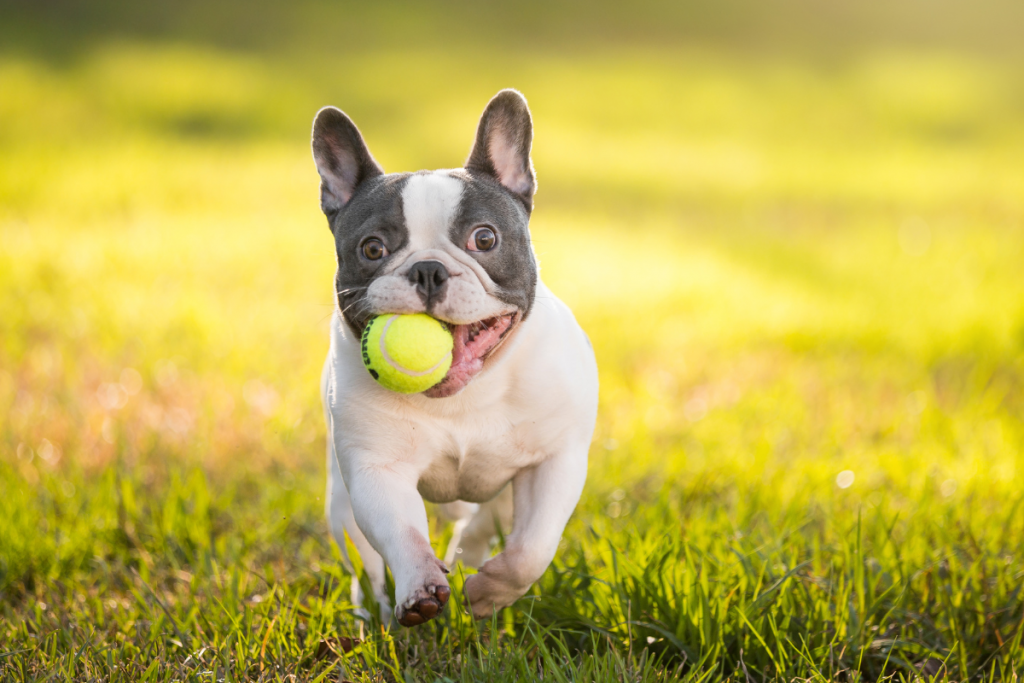

Behavior & Personality
Personality Milestones To Expect At 3–4 Months
- Chasing their tail, thrown objects, or other animals: 3 months
- Beginning to recognize their name: 3 months
- Beginning independent exploratory behaviors: 4 months
Build Your Puppy’s Confidence & Social Skills
Months 3–4 are a continuation of a critical socialization period that starts during your puppy’s first month home (8–12 weeks old)1. As their brain develops, this is a vital time to begin forming social skills, personality, and future behavior. Every new experience or situation your puppy encounters helps them decide who and what to befriend, and what to keep their distance from. This is why it’s so important to help them develop these skills by introducing loads of fun, enjoyable experiences early on.
Remember that your puppy’s brain development is also going through fear periods at this age1. There may be certain weeks where they seem more easily spooked or shy, and other weeks where they’re more outgoing and curious. These attitudes may bounce back and forth. It’s your job to recognize situations and objects that may seem scary or overwhelming in the eyes of your pup, even when it’s ordinary and harmless to us. To them, this world is new and big and sometimes a little scary. Be patient!
Make New Experiences Less Scary
Step 1: Slowly introduce your puppy to a new situation for only a few seconds to gauge their initial reaction.
Step 2: Remove the object, or remove your puppy from the situation if you see them tucking their tail, shaking, flattening their ears, growling, barking, licking their lips, or yawning. These are signs of stress or anxiety.
Step 3: Give them a treat and praise to help create a positive association with the situation that spooked them.
Step 4: Try again later. Repeat with treats, praise, and time to calm down in between.
Introduce Your Puppy To These Different Objects, People, & Situations:
- Men, women, & children (supervised) of all ages, heights, ethnicities, genders, hair colors, and people with beards, glasses, braces, canes, wheelchairs, etc.
- Other vaccinated dogs that you know well (NOT the dog park until your puppy is fully vaccinated, and even then, take caution).
- People in uniforms (mailmen, police officers, etc).
- People riding bikes, skateboards, rollerblades, etc.
- Walk them outside where they may safely see cars, garbage trucks, mail trucks, bikes, etc.
- Inanimate objects like phones, keys, balloons, and sports gear. Let them look at, hear, and smell objects. Do not let them chew or touch objects that could cause them harm or that you don’t want damaged.
- Introduce noisier objects like vacuums, washing machines, TVs, or outdoor yard equipment more slowly. Try leaving an unplugged vacuum in the same room for a day. Next, try turning on the vacuum in a separate room. Give treats! Slowly work up to the vacuum being on in the same room.
- Once your puppy is fully vaccinated, gradually introduce them one-on-one to other dogs in a controlled situation while both are leashed.
| Behavior & Personality Development To-Do List: |
|---|
| ☐Introduce your puppy to 90 different low-stress, enjoyable situations before they reach 14 weeks. ☐Be aware that puppies go through fear periods during this time, where they may be more easily spooked by new things. Take introductions slowly and use lots of treats to create positive associations with new experiences. |
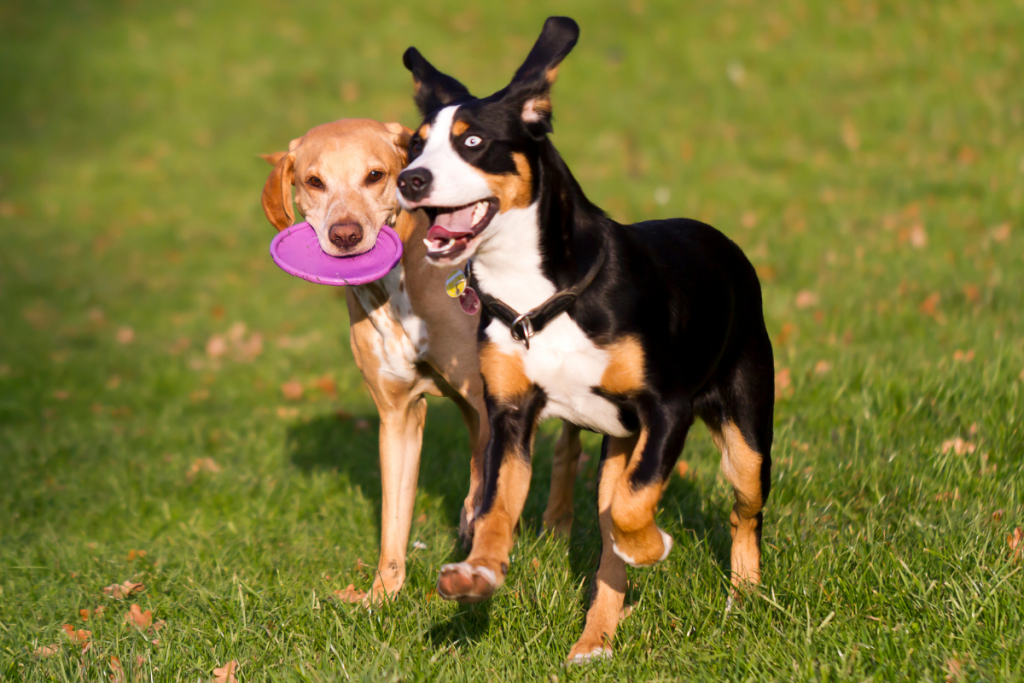

Health & Wellness
By 3 months, your puppy should have already had their first vet visit to check their overall health, received their first dose of core puppy vaccines (DA2PP or DAP), been dewormed, and started flea/tick and heartworm preventatives.
Vaccinations
Vaccinations are one of the most important first steps to protect your puppy’s long-term health. Just a few decades ago, before the existence of vaccines, the mortality rate for puppies was very high. Because of deadly diseases like distemper, puppies had a roughly 50% chance of survival after contracting it1. Vaccines protect against these now easily avoidable life-threatening illnesses with one little poke. A couple more vet visits during months 3–4 will complete each booster series and give your pup full protection.
Follow-Up Vet Visit Schedule For Puppies 3–4 Months Old6,7
| Age Of Next Puppy Vet Visit | Purpose Of Vet Visit |
|---|---|
| 12 Weeks Old (3 Months) | Second dose of DA2PP or DAP Rabies vaccine (if required this early by your state law) |
| 14 Weeks Old (3.5 Months) | Third dose of DA2PP or DAP Rabies vaccine if not already given (typical date of first dose) |
When Does My Puppy Need Booster Vaccines?
- 12 Weeks Old (3 Months): Second dose of DA2PP or DAP1,7. Some states, like California, may also require the first dose of the rabies vaccine at this age6.
- 16 weeks old (3.5 months): Third and final puppy booster for DA2PP or DAP1,7. If the rabies vaccine was not already given at 12 weeks, your puppy will get it at 16 weeks, which is the more typical age for a first dose.
Why Are Multiple Vaccine Doses (Boosters) Needed This Early?
Puppies do receive a certain amount of immunity from their mom when they’re born. However, this natural immunity fades over the first 3 months before the puppy’s own immune system is fully functioning1. This means that without vaccines, puppies have a higher chance of contracting life-threatening illnesses.
The tricky part is that the natural immunity puppies receive from their mom needs to be low enough to allow their own immune system to kick in and make antibodies in response to a vaccine. As your puppy shifts from Mom’s natural immunity to their own immune system revving up, there has to be a sweet spot for vaccines to work1. Booster shots ensure that your pup’s own immune system has enough time to create adequate antibodies on its own.
Does My Puppy Need Any Other Vaccines?
The answer depends on you and your puppy’s lifestyle, geographic location, and risk of being exposed. There are additional non-core vaccines—leptospirosis, Bordetella, Lyme, canine influenza, and the western diamondback rattlesnake toxoid—that can help protect your pup from illness if they’re more likely to be exposed7. A discussion with your veterinarian can help you decide which non-core vaccines are right for your puppy.
Can My Puppy Be Around Other Dogs Before They’re Vaccinated?
Your puppy should not be around unvaccinated dogs or puppies until they are fully vaccinated (no dog parks, no pet hotels, no doggie daycare). However, after they receive their first dose of core vaccines and dewormer, you should talk to your vet about allowing your puppy to join puppy classes.
These first few months are so critical in helping develop your puppy’s future personality and behavior through proper socialization that many vets agree the benefit of attending puppy classes after one round of vaccines far outweighs the risk1.
What Happens Once My Puppy Is Fully Vaccinated?
Once your vet gives you the “ok,” you can begin to expand your puppy’s world. Go for leashed walks around town or in a park. Feel free to introduce them to new dogs, but do so with caution in controlled situations. Remember that your puppy is still easily spooked at this age. Larger dogs and big groups of dogs may be intimidating to a tiny pup. For that reason, it’s best to start with one-on-one meetings with both dogs leashed, as opposed to letting them free in a dog park.
What Illnesses Do Vaccines Protect Against?
Core Vaccines:
- Distemper: Causes respiratory, neurological, and gastrointestinal (GI) illness. Highly contagious with a mortality rate at 50% (worse in puppies).
- Adenovirus2 (hepatitis): Causes respiratory disease.
- Parvovirus: Causes severe GI disease, which can be fatal. Most common in puppies under 6 months old; highly contagious.
- Parainfluenza: Causes upper respiratory tract disease and is contagious in high-density settings, like at doggy day camps.
- Rabies: Fatal if not treated. Causes brain inflammation and disrupts the nervous system.
Non-Core Vaccines:
- Leptospirosis: Shed through the urine of many animals. Attacks kidneys and sometimes the liver. Can be fatal if not treated by antibiotics1.
- Bordetella: Causes upper respiratory infections. Often spread in animal shelters, pet hotels, doggie daycares1.
- Lyme: Contracted through bites from infected ticks. Causes joint pain, weakness in limbs, loss of appetite, fever, kidney complications.
- Influenza: Causes upper respiratory infections. Often spread in animal shelters, pet hotels, doggie daycares1.
- Western diamondback rattlesnake toxoid: Vaccine effective against diamondback rattlesnake bites and similar snakes commonly found in CA, TX, AZ, OK, and NM. These snake bites cause pain, numbness, swelling, and can be fatal.
Other Topics To Discuss With Your Vet At 3–4 Months Old:
- Pet Insurance: While not required, if you do decide to buy pet insurance, it’s best to do so as early on in your puppy’s life as possible to avoid exemptions due to “pre-existing conditions” later.
- Dental Check-Up: Your vet should do a routine dental check to look for any abnormalities.
- Puppy Classes: So important for socialization! Talk to your vet about their recommendations as to when you should begin puppy classes—they may even have suggestions on where to go.
- Microchipping: Dog parents often like to wait to microchip their pup during their spay/neuter to make them more comfortable. However, if your puppy is an explorer, you can talk to your vet about microchipping early.
Related Article: Is Pet Insurance Worth It For Your Dog?
| Health & Wellness To-Do List: |
|---|
| ☐ Second vet visit at 12 weeks for second dose of core vaccines (DA2PP/DAP and rabies if required by law this early). ☐ Third vet visit at 16 weeks for final puppy vaccines (DA2PP/DAP and rabies if not already given). ☐Ask your vet about non-core vaccines for your puppy’s lifestyle and location. ☐If you’re considering buying pet insurance, purchase it while your puppy is still young and healthy. ☐Talk to your vet about puppy classes after their first set of vaccines. |
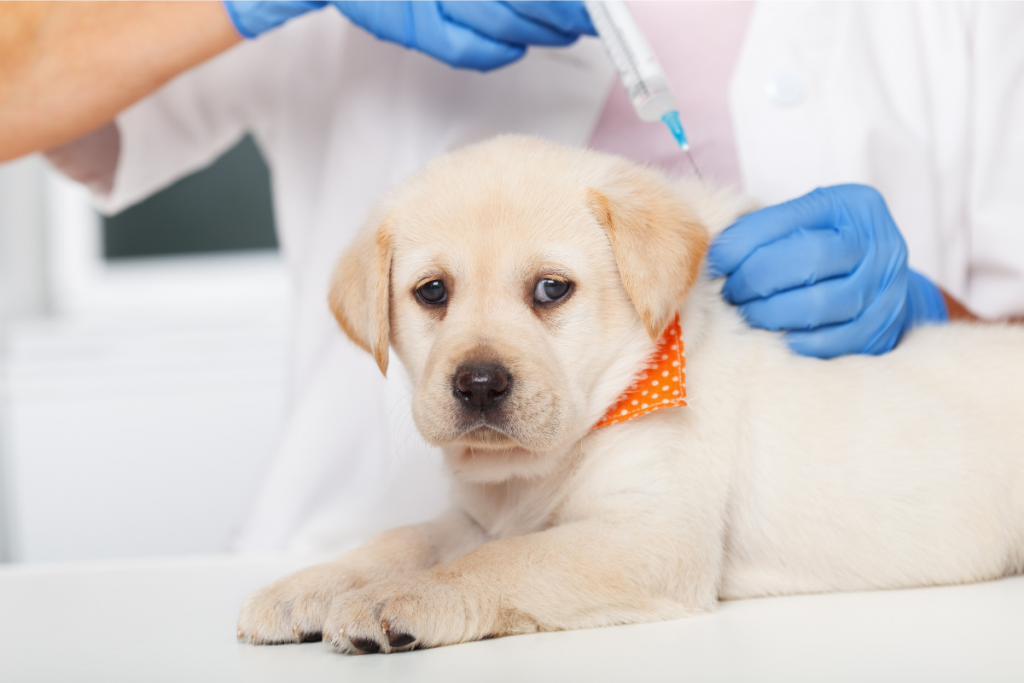

Food & Nutrition
By now you should have already decided on a puppy diet, and are working with your pup on a consistent eat, sleep, and potty routine. As your puppy grows, you’ll start to notice they need less sleep, and require less frequent meals and potty breaks. They will fall into a more manageable routine—probably juuust before you’re about to rip your hair out from sleepless nights and cleaning up pee puddles.
Eat, Sleep, & Potty Routines For Age 3–4 Months
Eat (Recommended Feeding Frequency)1:
- Extra-small & small breeds: Feed 3x daily until 4 months, then 2x daily
- Medium breeds: Feed 3x daily until 6 months, then 2x daily
- Large & giant breeds: feed 3x daily until 6 months, then 2x daily
Always do you own research when picking the perfect food for your pup, but if you need a place to start, try BARK Food for puppies! Get 25% off and forever free shipping with code 25FOOD.
Sleep (Typical Rest Needed):
Puppies rack up more total sleeping hours during a 24-hour period than adult dogs, but tend to sleep less at night and more during the day compared to adult dogs9. Hang in there! Their sleeping patterns will slowly sync up with yours in the next few months.
- 3 Months Old: Will need around 15–16 hours of sleep per day
- 4 Months Old: Will need around 11–12 hours of sleep per day9
Potty Frequency:
- 3 Months Old: 6–10 potty breaks per day2
- 4 Months Old: 4–8 potty breaks per day2
Ideal Body Weight For Puppies
It’s important to keep your puppy within the recommended weight range as they grow. As much as we love squishy, chonky pups, obesity can cause joint pain, make breathing difficult, keep your pup from enjoying everyday activities, and worse yet, lead to severe health issues like heart disease and diabetes.
Your veterinarian can help you learn how to assess proper weight and feeding proportions, but as a general guideline, you’re aiming for your puppy to have the “hourglass” figure1. At 3 months, your puppy may not yet be grown enough to have a waist, so let your vet help guide your interpretation1:
- When viewed from above, your puppy should be narrow at the waist.
- When viewed from the side, your puppy’s belly should tuck up after the ribcage.
After talking to your vet, you can view and download these helpful puppy growth charts to better assess and track your dog’s ideal weight and growth from home, or check out the Chonk Chart below for a general idea.
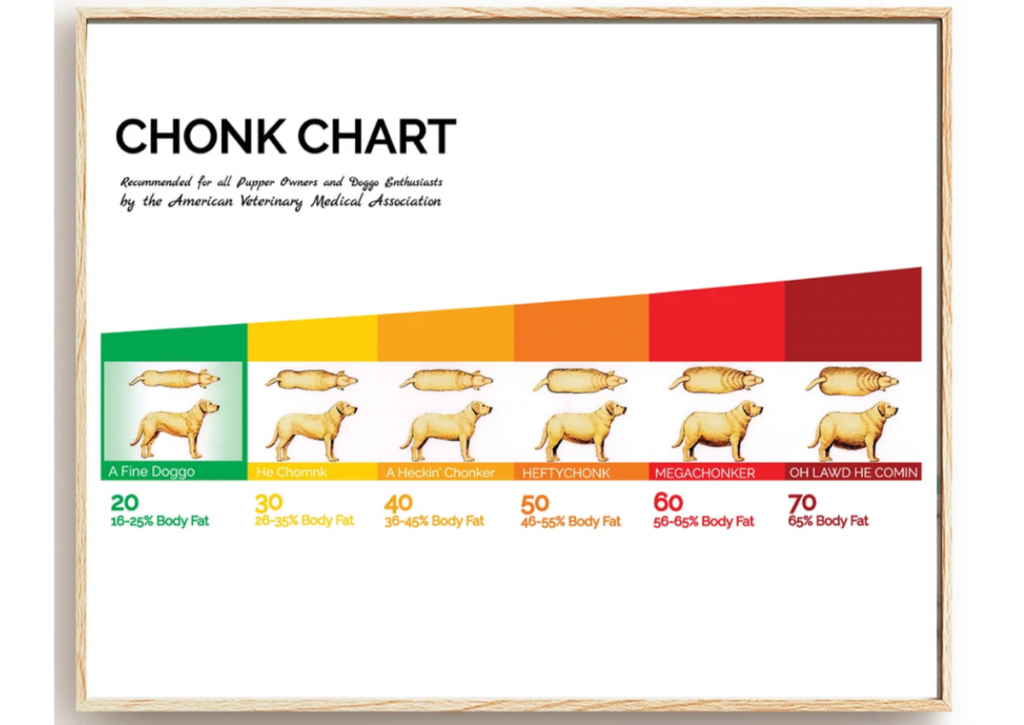

Foods & Substances Toxic To Puppies & Dogs10
Although we covered this list in Puppy Survival Guide Weeks 8–12, it’s important enough to repeat here for easy access:
Alcohol
Antifreeze
Caffeine
Chocolate
Cigarettes, nicotine, e-liquid for electronic cigarettes
Compost
Dishwashing liquid, detergent/dishwasher tablets
Fabric softener sheets
Grapes & raisins
Ibuprofen & naproxen
Cannabis
Minoxidil (Rogaine)
Mosquito repellant with DEET
Nasal decongestants
Nuts (particularly macadamia nuts)
Onions, garlic, chives
Pesticides & rodenticides
Topical medications
Wild mushrooms
Xylitol
Yeast dough
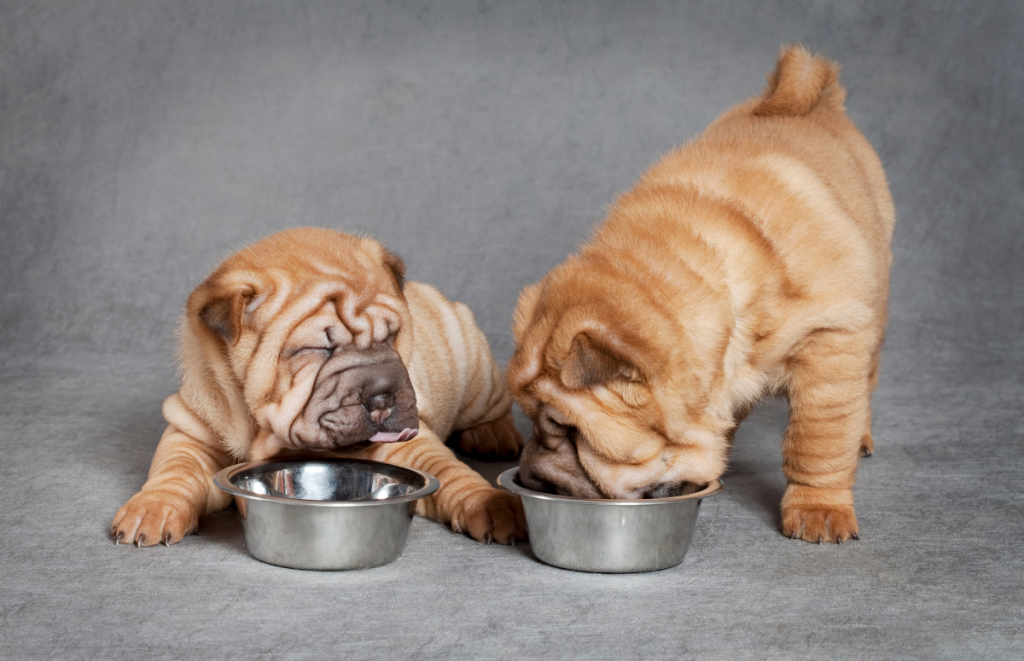

Training
By now you should already be in the process of working on potty training with your puppy, as well as not biting/mouthing, walking on a leash, how to sit, and teaching them their name. For refreshers on potty training and puppy biting, hop to the training section over here.
Basic Commands To Teach Your 3–4 Month-Old Puppy
Follow the links in this list for detailed instructions on how to teach each command.
- Sit (continued from last month)
- Stay
- Lie down
- Leave it/ drop it
- Come
- Fetch
- Shake hands/paw
Manners & Appropriate Behavior
Even more essential than teaching new tricks at this stage is focusing on redirecting any habits you don’t want sticking around as your puppy ages. For instance, if you don’t want your 100-pound Malamute on the couch when they’re fully grown, don’t hold them in your lap on the couch as a puppy. Here are some habits you may want to consider breaking early:
- Stop your puppy from jumping on you or house guests.
- Don’t encourage your puppy to chase or bite at your wiggling fingers or toes
- Stop your puppy from chewing on anything other than their own toys and treats, and recognize that chewing is often a sign of boredom or lack of exercise.
- Switch from pee pads to potty training during this time unless you want your dog depending on pee pads.
- Don’t allow your dog to beg and don’t share food with them from the table. This will become a life-long habit.
- Discourage excessive barking from things you don’t want them to bark at. For example, if your dog barks to be let outside to chase rustling leaves and you oblige, you’re encouraging that behavior to continue in the future.
Redirect Your Puppy Toward Good Habits
Although each training scenario requires slightly different techniques and methods of redirecting, there are a few universal truths when it comes to teaching your puppy good habits and manners:
- Puppies Learn Better & Faster With Positive Reinforcement12: Giving your puppy treats or praise for doing something you like will help them learn more quickly than punishing them for something you don’t. For instance, giving a treat and praising each time they pee outside helps puppy brains solidify this new skill more efficiently than when they’re yelled at or scolded for having an accident inside the house. Negative reinforcement like this is more likely to confuse or scare them—if they determine that peeing in the house causes shouting, they will instead learn to better hide their accidents.
- Puppies Don’t Understand Delayed Punishment13: If you get home from work and find an accident on your bed or chewed-up shoes, yelling at your puppy after the fact will do nothing but frighten and confuse them. They already forgot about what they did, and have zero idea why you’re yelling.
- Redirect In The Middle Of An Unwanted Habit: Is your puppy in the middle of chewing something, or in mid-pee on the living room rug? Don’t yell or hit. Simply stop them in the middle of the unwanted behavior, redirect them to the behavior you want (i.e. take away the object they’re chewing and give them a toy, or carry them outside to finish peeing). Reward with treats for the good behavior.
Begin Crate Training
Note: The number one rule of crate training is that a puppy’s crate should NEVER be used for punishment!
A crate should be your puppy’s safe haven—similar to a den in the wild. This is a place where your puppy should feel completely comfortable; where they can take a nap and decompress, or hang out while you run to the store or can’t keep an eye on them.
Helping your puppy learn that their crate is a safe, good place requires training and encouragement just like any new situation:
- Choose A Crate: You’ll want a crate that’s big enough for your puppy to sit, turn around, and lie down in. You don’t want it so big that they can go potty in one corner and sleep in another11.
- Make It Cozy: Put the crate in a room where your family spends a lot of time. Leave the door open and throw treats in. Allow your puppy to explore the crate with the door open. Put some toys, food, or a blanket in the crate with the door open until they feel comfortable going in and out on their own11.
- Shut The Door Once They Feel Comfy: Wait until your puppy feels completely comfortable with the crate before you do a door-shut trial. For the first time, shut the door for a few seconds, open it back up and give your puppy a treat.
- Gradually Increase Crate Times: At first, give them a longer lasting treat or chew that will distract them enough to not mind the door being closed for a few minutes (do not leave them unsupervised). Slowly increase your puppy’s crate time during naps or mealtimes.
- Bedtime: Once your puppy feel happy and comfy in their crate, you’re ready for bedtime. Move the crate into your bedroom (your puppy will sleep easier near you, and you’ll hear if they whimper to go potty), or buy a second crate11. Give treats at bedtime.
- Crying And Whining May Be A Sign You’re Moving Too Quickly: Other than whimpering for a potty break during the night, if your puppy is crying from being in the crate, you may have moved too fast11. Try taking it back a few steps and repeat.
- Don’t Confine Your Puppy Longer Than They Can Go Without A Potty Break: Do not leave a young puppy in their crate all day while you’re at work when they cannot physically hold it yet11. You’ll need to stop at home on your break, have a family member take the puppy out, or hire a dog walker to let them out while you’re away.
- Don’t Be Afraid To Seek Help: If you’re having trouble with crate training, reach out to your vet for advice. They can direct you to training specialists in your area.
Puppy Classes
Research has shown that puppies who attend puppy classes have a better chance of growing up to be less aggressive, more easily trainable, less socially fearful and anxious, and able to handle touch more easily14.
After your puppy receives their first round of core vaccines and dewormer, talk to your vet about when it’s ok to sign up. Although it’s important to keep your puppy away from other unvaccinated dogs and puppies this early on, early socialization is vital for developing their personality and behavior. That’s why most vets give the green light to start puppy classes after at least one round of vaccines1.
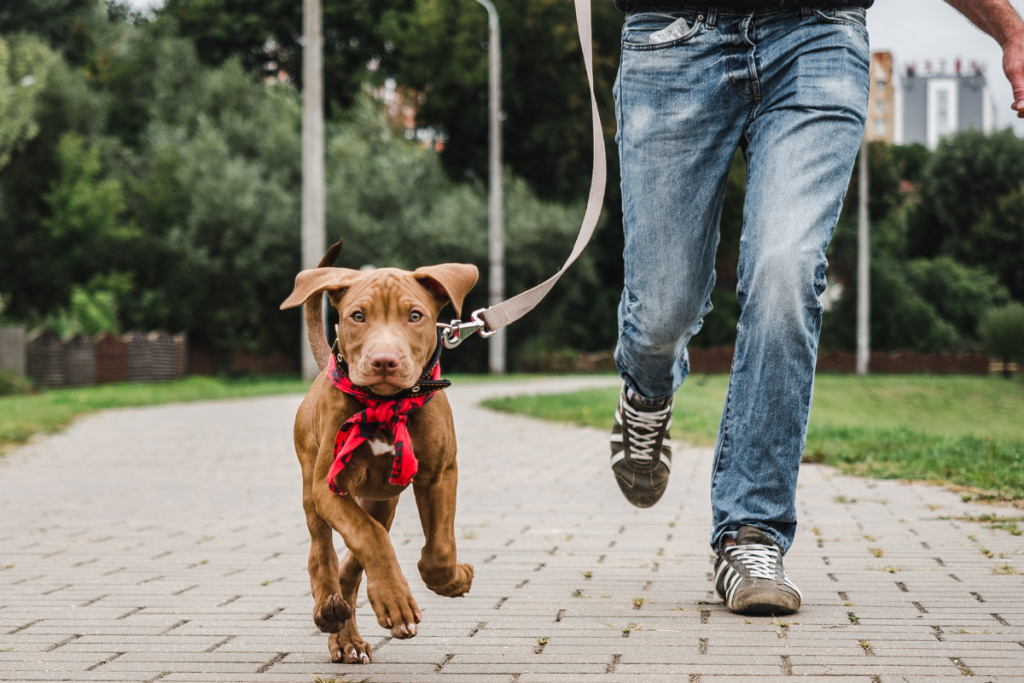

Puppy Safety
By now you should have properly puppy-proofed your home, acquired a carrier or harness that buckles into the car, purchased puppy-safe toys (not too hard, no tiny pieces), and gotten a collar with an ID tag. Need a refresher about this list? Pop on over here.
Take The Next Steps In Puppy Safety
You got the basics covered, and that’s great! As your puppy starts getting more active and exploring on their own around 3–4 months old, you may want to consider additional safety precautions:
- Keep Their Collar On In The House: This is especially important during thunderstorms, fireworks, or with guests visiting. Some folks let their pups go “naked” around the house, but should they get spooked or slip through doors, you’ll want them to have their ID tag.
- Take Their Collar Off When Leaving Them In A Crate Alone: Collars and ID tags can get tangled or stuck on crate bars. At the very least, this can get your pup stuck in an awkward position, at worst, it can cause strangulation.
- Don’t Leave Toys Or Chews In Your Pup’s Crate When They’re Alone: Destroyed toys or chews gnawed down too small can become a choking hazard all too quickly.
- Microchipping: Ask your vet about getting your puppy microchipped—if they get lost and turned in to any vet office, staff can scan the chip to retrieve your contact information and get your puppy home.
- Puppy Nanny Cam: In-home cameras allow you to keep an eye on your pup while you’re out. Some even let you talk to your dog or throw them treats automatically!
- Jingle Bell Collar: Some old-fashioned tips never go out of style. At this age your puppy is still pretty small. If you’re not paying attention, they have a tendency to run underfoot and laugh at you as you trip and fall (or so we imagine). A jingle bell can help you keep track of where they are in the house.
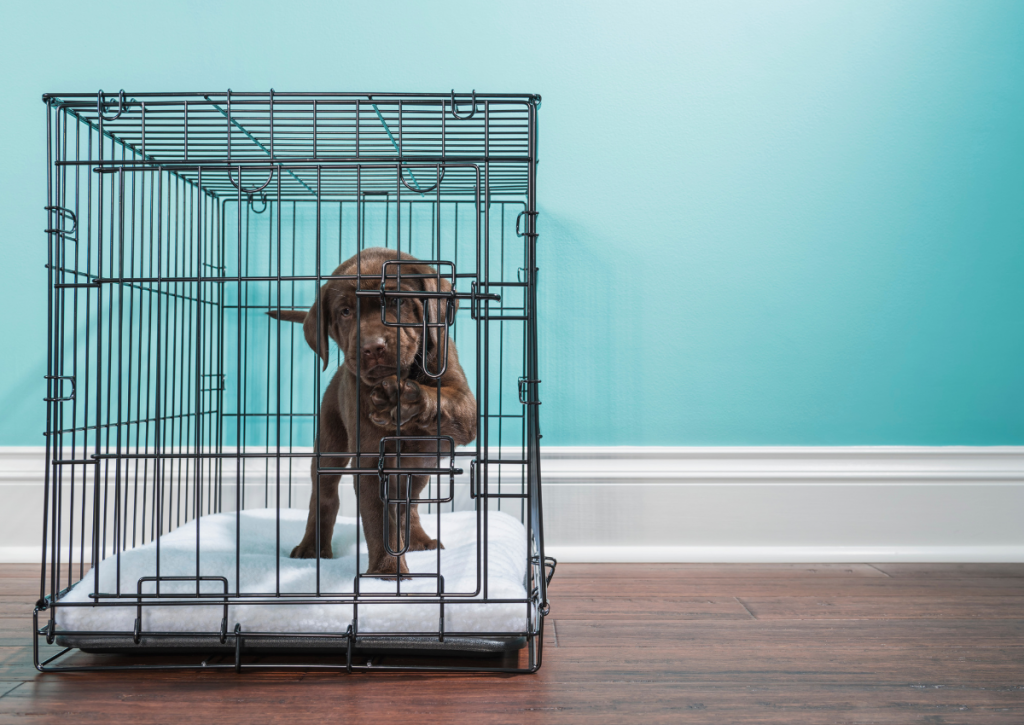

Puppy Products To Purchase At 3–4 Months Old
Need an essential product refresher? Check here!
Additional Products/Memberships For Your 3–4 Month Old Puppy
- Puppy Classes
- Puppy Crate
- Pet Insurance
- Daily Dental Kit
- Puppy Nanny Cam
- Jingle Bell for Collar
- Microchip
- MORE TOYS!
Emergency Resources
ASPCA Animal Poison Control
If your puppy eats something they shouldn’t, call the animal control poison center at (888) 426-4435.
Emergency Vets
If your puppy has an emergency when their regular vet is closed, you may need to find a 24/7 emergency vet near you. Emergency Vets USA enables you to search for an emergency vet by state or call (855)-778-6815.
Lost Pet
National hotline for reporting lost pets 1 (800) 486-2631.
Dog CPR How-To
Dog CPR Quick Guide
Dog CPR Training Video
Choking Dog/Dog Heimlich Maneuver
Dog Heimlich Maneuver Training Video
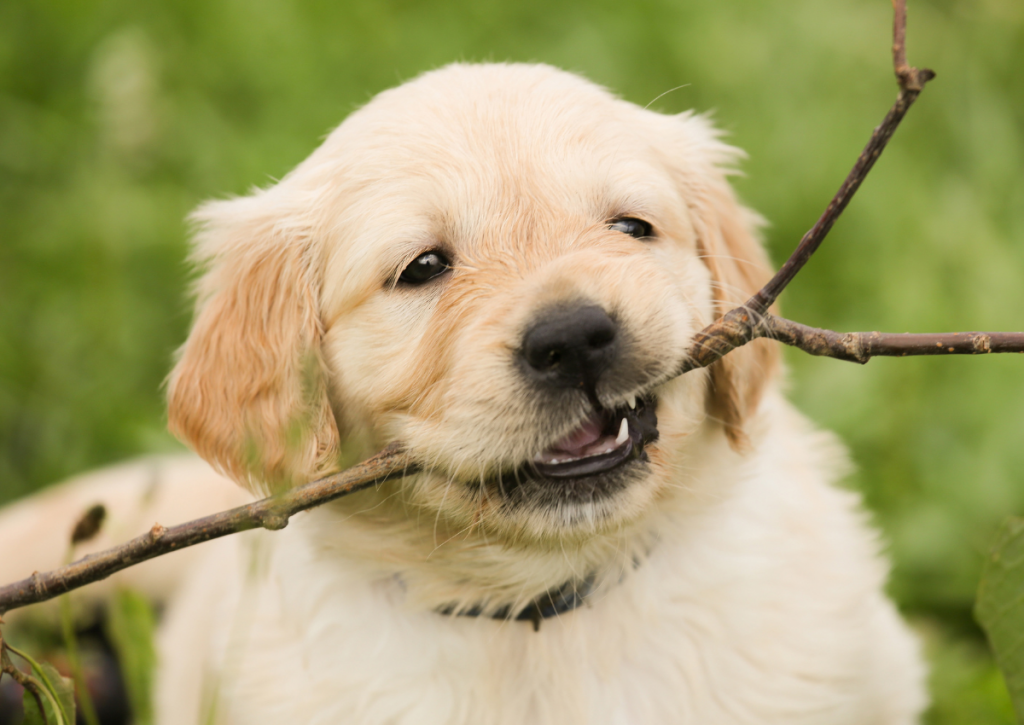

Sources
1Hennet, Margo. “Puppy Survival Guide.” 2 Mar. 2022.
2Youngerman, Claire. “House-Training Your Puppy.” Animal Health Topics , UC Davis | School of Veterinary Medicine, 24 Nov. 2021, https://healthtopics.vetmed.ucdavis.edu/health-topics/canine/house-training-your-puppy.
3Lewis, Georgia. “Musculoskeletal Development of the Puppy Birth to Twelve Months.” Research Gate, Hartpury University: Animal Therapy Magazine: Issue 15, 2019, https://www.researchgate.net/profile/Georgia-Lewis/publication/333118590_Musculoskeletal_Development_of_the_Puppy_Birth_to_Twelve_Months/links/5cdc8200299bf14d959c443d/Musculoskeletal-Development-of-the-Puppy-Birth-to-Twelve-Months.pdf.
4Hale, Fraser A. “Juvenile Veterinary Dentistry.” Veterinary Clinics of North America: Small Animal Practice , 2005, https://www.vetsmall.theclinics.com/article/S0195-5616(05)00023-9/fulltext.
5Enlund, Karolina Brunius, et al. “Dog Owners’ Perspectives on Canine Dental Health — A Questionnaire in Sweden.” Frontiers in Veterinary Science, Frontiers Media S.A., 9 June 2020, https://www.ncbi.nlm.nih.gov/pmc/articles/PMC7297050/.
6Gardiner, John. “Vaccination Guidelines for Dogs and Cats.” Animal Health Topics / School of Veterinary Medicine, 6 Dec. 2020, https://healthtopics.vetmed.ucdavis.edu/health-topics/feline/vaccination-guidelines-dogs-and-cats.
7“Recommendations for Core and Noncore Canine Vaccines.” AAHA (American Animal Hospital Association) , https://www.aaha.org/aaha-guidelines/2022-aaha-canine-vaccination-guidelines/recommendations-for-core-and-noncore-canine-vaccines/.
8Reisen, Jan. “How Much Sleep Do Puppies Need? Here’s How to Make Sure.” American Kennel Club, American Kennel Club, 29 Apr. 2021, https://www.akc.org/expert-advice/health/how-much-do-puppies-sleep/.
9Kinsman, R.; Owczarczak-Garstecka, S.; Casey, R.; Knowles, T.; Tasker, S.; Woodward, J.; Da Costa, R.; Murray, J. Sleep Duration and Behaviours: A Descriptive Analysis of a Cohort of Dogs up to 12 Months of Age. Animals 2020, 10, 1172. https://doi.org/10.3390/ani10071172
10DeGioia, Phyllis. “What First Time Puppy Owners Should Know.” Veterinary Partner, VIN, 28 June 2021, https://veterinarypartner.vin.com/default.aspx?pid=19239&id=10330034.
11“Indoor Pet Initiative.” Crate Training | Indoor Pet Initiative, https://indoorpet.osu.edu/dogs/puppy/crate-training.
12Karen L. Overall, “That Dog Is Smarter Than You Know: Advances in Understanding Canine Learning, Memory, and Cognition.” Topics in Companion Animal Medicine, Volume 26, Issue 1, 2011, Pages 2-9. https://www.sciencedirect.com/science/article/abs/pii/S1558787817302551
13Crowell-Davis, Sharon L. “Socialization Classes for Puppies and Kittens.” Vetfolio, Understanding Behavior, Nov. 2007, http://vetfolio-vetstreet.s3.amazonaws.com/mmah/27/0a520a6fdc40d7989ced4f29444e58/filePV_29_11_674.pdf.
14González-Martínez, Ángela, et al. “Association between Puppy Classes and Adulthood Behavior of the Dog.” Journal of Veterinary Behavior, Elsevier, 8 May 2019, https://www.sciencedirect.com/science/article/abs/pii/S1558787817302551.

